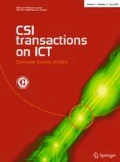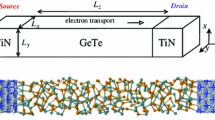Abstract
Amorphous semiconductors are an important class of semiconductors due to their low temperature deposition and high areal homogeneity over large areas which have been used mainly for display back panel driving circuits. Recent improvements in carrier mobilities in multi-component amorphous semiconductors have opened new area of applications for these amorphous semiconductors. To develop new multi component amorphous structures with optimized electronic properties, it is essential to understand the electron transport behavior in these materials. We have compared electronic structure of amorphous oxide and amorphous oxy-nitride semiconductors to understand the electronic transport in these semiconductors. We also propose certain methods to significantly reduce the computational time required to generate new multi-component amorphous structures and to study their electronic properties such that the development of new amorphous semiconductors with optimized electronic properties can be accelerated.



Similar content being viewed by others
References
le Comber P, Spear W, Ghaith A (1979) Amorphous-silicon field-effect device and possible application. Electron Lett 15:179
Hsieh H, Lu H, Ting H, Chuang C, Chen C, Lin Y (2010) Development of IGZO TFTs and their applications to next-generation flat-panel displays. J Inf Disp 11(4):160. https://doi.org/10.1080/15980316.2010.9665845
http://ncflexe.in/. Accessed 22 May 2019
Kamiya T, Nomura K, Hosono H (2009) Origins of high mobility and low operation voltage of amorphous oxide TFTs: electronic structure, electron transport, defects and doping. J Disp Technol 5(7):273
Nomura K, Ohta H, Takagi A, Kamiya T, Hirano M, Hosono H (2004) Room-temperature fabrication of transparent flexible thin-film transistors using amorphous oxide semiconductors. Nature 432(7016):488. https://doi.org/10.1038/nature03090
Nomura K, Kamiya T, Ohta H, Uruga T, Hirano M, Hosono H (2007) Local coordination structure and electronic structure of the large electron mobility amorphous oxide semiconductor In–Ga–Zn–O: experiment and ab initio calculations. PRB 75(3):035212. https://doi.org/10.1103/PhysRevB.75.035212
Takagi A, Nomura K, Ohta H, Yanagi H, Kamiya T, Hirano M, Hosono H (2005) Carrier transport and electronic structure in amorphous oxide semiconductor, a-InGaZnO4. Thin Solid Films 486(1):38. https://doi.org/10.1016/j.tsf.2004.11.223.WOE-11, 2004
Yamaguchi N, Taniguchi S, Miyajima T, Ikeda M (2009) Optical and electrical properties of amorphous InGaZnO. J Vac Sci Technol B Microelectron Nanometer Struct Process Meas Phenom 27(3):1746. https://doi.org/10.1116/1.3110022
Ye Y, Lim R, White JM (2009) High mobility amorphous zinc oxynitride semiconductor material for thin film transistors. J Appl Phys 106(7):074512. https://doi.org/10.1063/1.3236663
Ye Y, Lim R, You H, Scheer E, Gaur A, Hsu Hc, Liu J, Yim DK, Hosokawa A, White JM (2013) 4.2: Invited paper: development of high mobility zinc oxynitride thin film transistors, SID symposium digest of technical papers, vol 44, no 1, p 14. https://doi.org/10.1002/j.2168-0159.2013.tb06127.x
Kim HS, Jeon SH, Park JS, Kim TS, Son KS, Seon JB, Seo SJ, Kim SJ, Lee E, Chung JG, Lee H, Han S, Ryu M, Lee SY, Kim K (2013) Anion control as a strategy to achieve high-mobility and high-stability oxide thin-film transistors. Sci Rep 3:1459. https://doi.org/10.1038/srep01459
Lee E, Kim T, Benayad A, Kim H, Jeon S, Park GS (2015) Ar plasma treated ZnON transistor for future thin film electronics. Appl Phys Lett 107(12):122105. https://doi.org/10.1063/1.4930827
Lee S, Nathan A, Ye Y, Guo Y, Robertson J (2015) Localized tail states and electron mobility in amorphous ZnON thin film transistors. Sci Rep 5:13467. https://doi.org/10.1038/srep13467
Lee E, Kim T, Benayad A, Hur J, Park GS, Jeon S (2016) High mobility and high stability glassy metal-oxynitride materials and devices. Sci Rep 6:23940. https://doi.org/10.1038/srep23940
Park J, Kim YS, Ok KC, Park YC, Kim HY, Park JS, Kim HS (2016) A study on the electron transport properties of ZnON semiconductors with respect to the relative anion content. Sci Rep 6:24787. https://doi.org/10.1038/srep24787
Yamazaki T, Shigematsu K, Hirose Y, Nakao S, Harayama I, Sekiba D, Hasegawa T (2016) Amorphous ZnOxNy thin films with high electron Hall mobility exceeding 200 cm2 V\(-\) 1 s\(-\) 1. Appl Phys Lett 109(26):262101. https://doi.org/10.1063/1.4973203
Jeong H, Kim D, Kwon H (2017) Enhanced electrical performance and stability in zinc oxynitride thin-film transistors via sequential ultraviolet and thermal treatment. IEEE Electron Device Lett 38(7):883
Noh HK, Chang KJ, Ryu B, Lee WJ (2011) Electronic structure of oxygen-vacancy defects in amorphous In–Ga–Zn–O semiconductors. PRB 84(11):115205 10.1103/PhysRevB.84.115205
Cho DY, Song J, Na KD, Hwang CS, Jeong JH, Jeong JK, Mo YG (2009) Local structure and conduction mechanism in amorphous In–Ga–Zn–O films. Appl Phys Lett 94(11):112112. https://doi.org/10.1063/1.3103323
de Jamblinne A, de Meux G, Pourtois J, Genoe P Heremans (2015) Comparison of the electronic structure of amorphous versus crystalline indium gallium zinc oxide semiconductor: structure, tail states and strain effects. J Phys D Appl Phys 48(43):435104. https://doi.org/10.1088/0022-3727/48/43/435104
Štich I, Car R, Parrinello M (1991) Amorphous silicon studied by ab initio molecular dynamics: preparation, structure, and properties. PRB 44(20):11092 10.1103/PhysRevB.44.11092
Kresse G, Hafner J (1994) Ab initio molecular-dynamics simulation of the liquid–metal–amorphous-semiconductor transition in germanium. PRB 49(20):14251 10.1103/PhysRevB.49.14251
Jarolimek K, de Groot RA, de Wijs GA, Zeman M (2010) Atomistic models of hydrogenated amorphous silicon nitride from first principles. PRB 82(20):205201. https://doi.org/10.1103/PhysRevB.82.205201
Glass CW, Oganov AR, Hansen N (2006) USPEX—evolutionary crystal structure prediction. Comput Phys Commun 175(11):713. https://doi.org/10.1016/j.cpc.2006.07.020
Oganov AR, Lyakhov AO, Valle M (2011) How evolutionary crystal structure prediction works-and why. Acc Chem Res 44(3):227. https://doi.org/10.1021/ar1001318
Lyakhov AO, Oganov AR, Stokes HT, Zhu Q (2013) New developments in evolutionary structure prediction algorithm USPEX. Comput Phys Commun 184(4):1172. https://doi.org/10.1016/j.cpc.2012.12.009
Nahas S, Gaur A, Bhowmick S (2016) First principles prediction of amorphous phases using evolutionary algorithms. J Chem Phys 145(1):014106. https://doi.org/10.1063/1.4955105
Giannozzi P, Baroni S, Bonini N, Calandra M, Car R, Cavazzoni C, Ceresoli D, Chiarotti GL, Cococcioni M, Dabo I, Corso AD, de Gironcoli S, Fabris S, Fratesi G, Gebauer R, Gerstmann U, Gougoussis C, Kokalj A, Lazzeri M, Martin-Samos L, Marzari N, Mauri F, Mazzarello R, Paolini S, Pasquarello A, Paulatto L, Sbraccia C, Scandolo S, Sclauzero G, Seitsonen AP, Smogunov A, Umari P, Wentzcovitch RM (2009) QUANTUM ESPRESSO: a modular and open-source software project for quantum simulations of materials. J Phys Condens Matter 21(39):395502. https://doi.org/10.1088/0953-8984/21/39/395502
Kohn W, Sham LJ (1965) Self-consistent equations including exchange and correlation effects. PR 140(4A):A1133. https://doi.org/10.1103/PhysRev.140.A1133
Perdew JP, Burke K, Ernzerhof M (1996) Generalized gradient approximation made simple. PRL 77(18):3865. https://doi.org/10.1103/PhysRevLett.77.3865
Mulliken RS, Rieke CA, Orloff D, Orloff H (1949) Formulas and numerical tables for overlap integrals. J Chem Phys 17(12):1248. https://doi.org/10.1063/1.1747150
W.R. Inc. Mathematica, version 11.0. Champaign, IL (2016)
Aradi B, Hourahine B, Frauenheim T (2007) DFTB+, a sparse matrix-based implementation of the DFTB method. J Phys Chem A 111(26):5678. https://doi.org/10.1021/jp070186p
Elstner M, Porezag D, Jungnickel G, Elsner J, Haugk M, Frauenheim T, Suhai S, Seifert G (1998) Self-consistent-charge density-functional tight-binding method for simulations of complex materials properties. PRB 58(11):7260. https://doi.org/10.1103/PhysRevB.58.7260
Moreira NH, Dolgonos G, Aradi B, da Rosa AL, Frauenheim T (2009) Toward an accurate density-functional tight-binding description of zinc-containing compounds. J Chem Theory Comput 5(3):605. https://doi.org/10.1021/ct800455a
Acknowledgements
Authors would like to acknowledge earlier work of Mr. Suhas Nahas towards effective use of evolutionary algorithm in generating amorphous structures some of which were used for further studies in this work. Authors also acknowledge computational support from Prof. Somnath Bhowmick for the generation of amorphous structures and discussions leading towards better understanding of computational methods. Authors acknowledge use of high performance computing (HPC) facility of IIT Kanpur for ab-initio based DFT calculations. Anshu Gaur would like to thankfully acknowledge support under YFRF Grant from MietY, GoI.
Author information
Authors and Affiliations
Corresponding author
Additional information
Anshu Gaur: YFRF Grant of Visvesvaraya Ph.D. Program under Digital India Corporation of Ministry of Electronics and Information Technology, Govt. of India.
Rights and permissions
About this article
Cite this article
Srivastava, J., Gaur, A. Understanding electronic transport in multi-component amorphous semiconductors. CSIT 7, 123–129 (2019). https://doi.org/10.1007/s40012-019-00246-7
Received:
Accepted:
Published:
Issue Date:
DOI: https://doi.org/10.1007/s40012-019-00246-7




